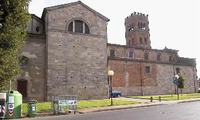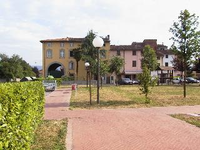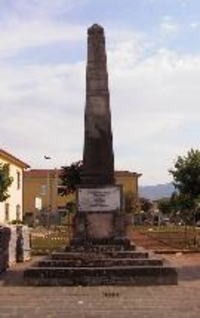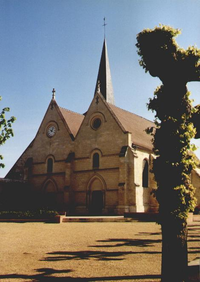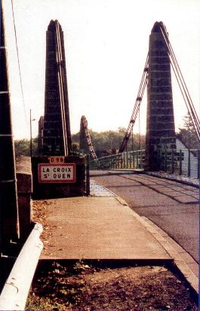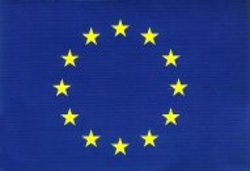Partnerships
Italy
Between the municipality of Losheim am See (16,000 inhabitants, 97 square kilometres in size) and the Comune di Capannori there has been a municipal partnership since 1993. Losheim was the first Saarland municipality to enter into a partnership with an Italian municipality. Although it is still quite young, it functions very well and is filled with life. Even the 1,000 km between the two towns are no obstacle, because on both sides there has already been a lively exchange between associations, organisations and young people, friendships have been made and interpersonal contacts have been established. All these are important prerequisites for a partnership to exist not only on paper. Losheim and Capannori are on the best way to learn from each other, to give mutual understanding in the two communities and to build a piece of Europe together.
The municipality of Capannori, Comune di Capannori
To the east of Lucca, a few kilometres from its city walls, is the municipality of Capannori, which with its 40 hamlets is one of the largest in Tuscany. The municipality of Capannori covers an area of 15,660 square kilometres and has 44,039 inhabitants. It is situated 16 m above sea level.
Capannori can be reached by the A11 motorway from Florence, Pistoia, Montecatini or from Genoa, Pisa, Livorno and Lucca. The railway station connects it with Lucca, Viareggio, Montecatini, Pistoia and Florence. Public transport also includes buses (C.L.A.P. and LAZZI) which leave from Piazzale Verdi in Lucca.
The rural municipality of Capannori, in the heart of Tuscany, in addition to its natural beauty and hiking areas, also boasts a great wealth of art. In the middle of this agricultural area, there are the villas that the rich merchants of Lucca had built in the past centuries and that still bear witness to a great past.
The terrible soil in this area led early on to the emergence of small but independent privately owned farms. These dwellings and farm buildings, called "corti", are still often found in the municipal area of Capannori.
In the past, agriculture was the main economic factor, but in the course of time, industries have also settled here. Especially the paper industry, but also the handicraft production of furniture offer jobs in this municipality.
In recent years, the production of olive oil has also regained interest; olive growing is mostly done together with wine growing, which has also gained in importance with the recognition and evaluation as D.O.C. - wine for the "Rosso delle Colline di Lucca".
France
The French municipality of La Croix Saint-Ouen is located on the edge of one of the largest forest areas in northern France in the immediate vicinity of Compiègne, the City of Kings, in Département 60 (Oise), administrative region Picardie, about 75 km north of Paris.
The French rural commune has 3,800 inhabitants and lives from medium-sized industry, but also from timber and agriculture. The mayor is Mr Guy Schott. First deputy is Mr Jean-Claude Robic, who is also responsible for the partnership.
In addition to the kindergarten and primary school, the commune has a collège (comprehensive school), a lycée (grammar school) and a vocational school. A lively club life ensures numerous leisure opportunities, with horse riding and beautiful walks in the surrounding forests being particularly recommended.
The partnership with Losheim am See
Official sealing of the community partnership in Losheim am See
Almost exactly 5 years after the twinning with the Italian municipality of Capannori, the official sealing of the twinning with the French municipality of La Croix Saint-Ouen took place on 3 October 1998 in a festive meeting of the municipal council in the Saalbau Losheim. In his welcoming address, Mayor Lothar Christ referred to the date of the official connection, which was initiated by the Losheim family Franz Bierbrauer through initial contacts.
He said that this partnership had not come about through the continuation of a school partnership, but had been brought into being from the very beginning by citizens and had already been filled with life through numerous mutual visits up to the day of the official sealing. In this context, he thanked the working group "Community Partnership with La Croix Saint-Ouen", its spokesman Friedel Schommer and the members for the commitment shown so far and paid tribute to them.
The cordiality of the meetings on both sides and the concrete plans had convinced everyone. He therefore asked that the enthusiasm shown so far also be brought to bear in the forthcoming deepening of the friendship between La Croix Saint-Ouen and Losheim am See, in order to fill the partnership with life at all levels, especially in the area of schools and associations, together with as many citizens of the community as possible. The purpose must be to bring people closer together in order to promote understanding and peace in freedom in both countries.
Mayor Lothar Christ addressed the young people and Losheim schools in particular. He thanked both the Peter Dewes comprehensive school in Losheim and the Losheim primary school, which have already made contact with schools in La Croix Saint-Ouen in order to work on a joint European project.
Christ expressed the wish and hope that this joint project work would bear fruit and lead to a school partnership between the two communities. For the most important task of the partnership will be special events to interest pupils and young people of the partner communities in the idea of a "united Europe".
A first step in the right direction was the European youth camp of the Saarland Gymnastics Federation in the summer, in which children from the partner communities of Capannori and La Croix Saint-Ouen had already participated.
He expressed his heartfelt thanks to Karl-Heinz Scherer, the camp director. This practical experience had shown that especially the young Europeans were called upon to cultivate contacts to other countries in order to get to know the problems and habits of life and to work on a pan-European solution. But also in economic areas Losheim's mayor wished for a cooperation between the two partner communities.
He hoped to be able to establish initial contacts within the framework of a new European project to promote the use of modern information and communication technologies. With the signing of the two documents, the partner communities wanted to set a sign of European brotherhood and make visible the will of both peoples to live together in peace and freedom.
Mayor Lothar Christ concluded: "In this sense, I wish our partnership to form a bond which, through contacts and mutual visits, will become ever stronger and more indissoluble and thus of lasting strength. I hope that the coming days of encounter will bring Europe a little closer to all of us. To you, dear guests from La Croix Saint-Ouen, I wish that you feel at home with us - at home in Europe! Long live the partnership between La Croix Saint-Ouen and Losheim am See! Long live the Franco-German friendship!"
Day of historical significance for both communities
His French counterpart, Mayor Guy Schott, also attached historical significance to the day, as the two municipalities of La Croix Saint-Ouen and Losheim am See officially entered into a municipal partnership. This Franco-German partnership corresponds to today's need, on the threshold of the year 2000, to cross borders. At the same time, it underscores the warm and lively relations that the German and French governments have maintained for decades. Finally, the partnership is a symbol of the need for a united and strong Europe. The strengthening of Franco-German relations was therefore a milestone on this path.
Partnership in the hearts of the people
The chairmen of the partnership associations Friedel Schommer and Jean Claude Robic also expressed their satisfaction that it had been possible to realize this pending partnership within a short time. For a good success of the partnership it is necessary that the people in both communities accept it with all their hearts. For this it is necessary that meetings take place in the future, whether they are organized by the partnership associations, by other associations or by private people in the cultural, educational, sporting or private spheres. Under these conditions, the community partnership between Losheim am See and La Croix Saint-Ouen will be a complete success.
Signing of the partnership documents
Mayor Lothar Christ and Mayor Guy Schott then signed the partnership deeds, which had been prepared several times. With their signatures, the decisions of the two municipal councils in Losheim am See and La Croix Saint-Ouen were officially executed and the municipal partnership sealed. The exchange of partnership certificates took place to the applause of those present, followed by a toast to Franco-German friendship and the exchange of gifts.
Hans Peter Steuer Partnership Association Losheim am See - La Croix Saint-Ouen
Schillerstr. 22 66679 Losheim am See Tel.: 06872 2234 Fax: 06872 887069E-Mail
Click here to go tohttp://www.ville-lacroixsaintouen.fr/
DR Congo
The Cité de Bokungu is the capital of the territory of the same name in the district of Tshuapa of the Equateur - Province of the Democratic Republic of Congo with over 200,000 inhabitants on about 20,000 km2. It is located in the large equatorial rainforest on a tributary of the Congo River, 500 river kilometers from the provincial capital Mbandaka and about 1500 km from Kinshasa.
The Cité de Bokungu is the capital of the territory of the same name in the district of Tshuapa of the Equateur - Province of the Democratic Republic of Congo with over 200,000 inhabitants on about 20,000 km2. It is located in the large equatorial rainforest on a tributary of the Congo River, 500 river kilometers from the provincial capital Mbandaka and about 1500 km from Kinshasa.
The area around Bokungu was the scene of the "Shadow over the Congo", the brutal exploitation of rubber by the Belgian King Leopold II, which destroyed the old social structures and wiped out about half of the population. After the decades as a Belgian colony, the following dictatorship of Mobutu and in consequence of the first African world war of 1997-2004 with its nearly 5,000,000 dead in consequence, the economy is in ruins, the infrastructure is destroyed and there is extreme poverty in the remote area. The successful democratic elections of 2006 give hope for change.
Since 2004, project relations have existed between the Cité de Bokungu and the municipality of Losheim am See, mediated by Wolfgang Leinen from Losheim, who worked in the diocese of Bokungu - Ikela from 2002 to 2007. In the summer of 2008, the Losheim municipal council decided to enter into a town twinning arrangement with Bokungu, which was sealed on 24.9.08 with the ceremonial signing of the twinning documents in the Losheim town hall on the occasion of a visit by the Chef de Cité, Mme Martine Ekila Yafe.
Bokungu is a school centre for the territory with a kindergarten, 4 primary schools, 5 secondary schools and a medical-technical institute. The maintenance of the buildings, which date back to the time of the colonizers or the missionaries, exceeds the possibilities of the population of 25,316 by far, in addition to which they have to pay the school fees and bear the full risk of illness. Even the daily food for the family poses considerable problems for quite a few in the administrative centre. In addition, swine fever recently wiped out all the animals in the town. In the villages, the people grow maize, beans, soya and rice as well as cassava, the main staple food. They also engage in fishing, fishponds and the rearing of small livestock. The only thing they lack is access to the distant markets of the big cities.
Because of its valuable natural resources, Bokungu has become the target of unscrupulous profiteers since the end of the war, including logging companies and metal collectors, to whom the ancestral objects from the iron and copper working era fall victim. Together with friends, the people at Tshuapa are trying to organise themselves. A great success: with international support they succeeded in 2008 to declare the sale of 500.000 ha of forest invalid.
Projects
Support for local handicrafts
The aim is to organise the craftsmen working individually or as a family, so that traditional methods and products, and thus cultural identity, are preserved and find a market again. The leaf fibres of the raffia palm are used to weave cloth. In earlier times they were used as loincloths. Even today, the Kitawala group, who refuse the "white" influences, still use the raffia webs to make clothes. Backpacks made from the same webs serve as very sturdy "suitcases" for the population. Often they contain the whole belongings of the people. The fabrics are traditionally dyed with natural dyes made from boiled barks, roots and leaves. Since the palm tree is used sustainably, the raffia products are also of high ecological quality. The patterns vary from family to family, or village to village.
The current backpacks, "Molokai", are handmade by students from the remote villages to earn their school fees. The surplus is used to finance social projects of local organizations such as the fight to save the rainforest and the local culture, reconstruction and maintenance of schools, a program of "natural medicine" based on the medicinal plants of the rainforest, in short to strengthen local resources.
Further: Incense is collected in the forest. It serves as a source of light for the population. Untreated, it gives off a subtle soothing scent when heated. Lufa, the natural brush for body care and washing up, comes from wild plants, as do the spices.
Reconstruction of the state secondary school
While the denominational schools are partly supported by church partners, the state institutions are almost without anything. The state secondary school of Bokungu is a building made of dried mud bricks and covered with corrugated iron. Tropical rains and storms keep gnawing at the building, which has partially collapsed. The roof sheets have rusted after about 40 years, some of them destroyed by the wind, so that the preservation is becoming increasingly impossible. New sheets would be needed to make the school fit for the next 40 years. The traditional palm thatch roofs are not an alternative for the large building, as they have to be renewed every 6-10 months and are difficult to obtain in the vicinity of the town. To bring one sheet to Bokungu, one has to invest 20 EUR. 200 metal sheets would be necessary to construct a solid roof. The monthly salary of the mayor is just the equivalent of 1.5 metal sheets; the vast majority have no paid work. Within the framework of the partnership visit, the Losheim mayor has given start-up financing to Bokungu. Further actions will support the progress of the project.
Town hall of Bokungu on the brink of ruin
Already severely damaged by the military occupation during the war, the simple mud-brick building dating from colonial times is literally on the brink of the abyss. An erosion has eaten its way up to 4 meters. The road in between is already unusable. A replacement must be found in the foreseeable future. Again, Losheimers want to help raise the missing funds for a permanent solution.
Further projects:
Lisalisi children's emergency centre, Lifala girls' primary school, St Joseph's crafts school, Médecine Naturelle (selection).
Donations
Donations can be made to this account at Volksbank untere Saar eG, IBAN: DE76 5939 2200 0000 0075 87, under the keyword "Project/Partnership Congo".
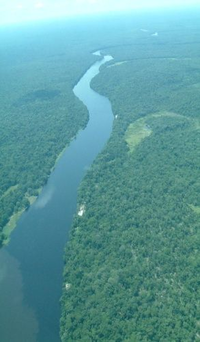
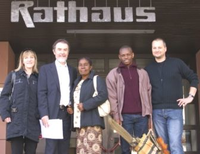


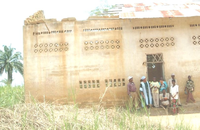
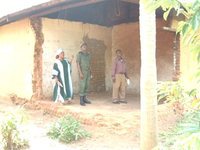
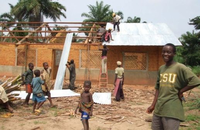
Benin
The working group "Losheimer helfen in Afrika" (Losheimers help in Africa) looks after projects in Africa. The community of Losheim am See has agreed a partnership with Copargo/Benin. Copargo is about 850 square kilometres in size and has about 50,000 inhabitants, half of whom are under 16 years of age. The town lies 600 km north of the coast in an open savannah.
EU support for town twinning
The EU's Europe for Citizens funding programme in this area is divided into four Actions. Action 1 is entitled: Active citizens for Europe and covers activities that promote active participation of citizens. Measure 1 in this Action 1 concerns town twinning. EU support for town-twinning activities is again divided into two areas: Town Twinning Citizens' Meetings (Measure 1.1), i.e. the classical exchanges between twinned towns, and the creation of thematic networks between twinned towns(Measure 1.2), i.e. measures such as conferences, seminars and workshops.
More detailed information on the Europe for Citizens Programme and its sub-measures can be found in the Provisional Programme Guide, which presents the content of the Programme and explains the procedures and conditions for applying for a grant under the different actions and measures of the Programme. Application form available here. (Source: Circular SSGT 16.1.07)



